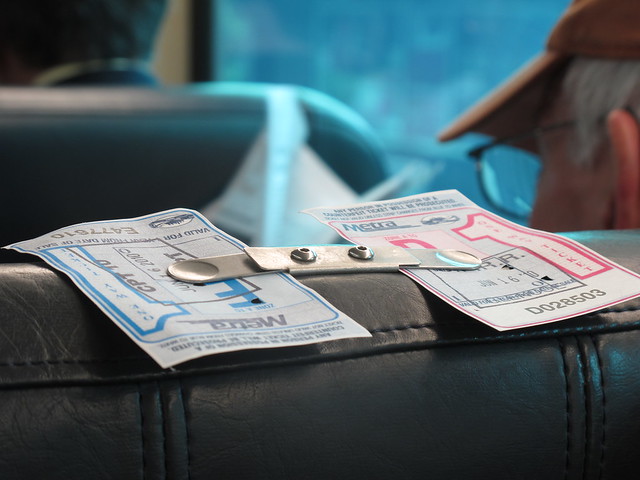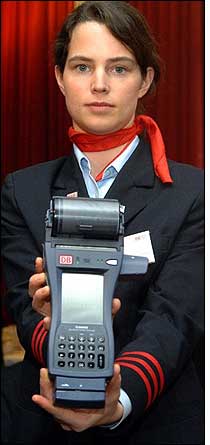
Even though Metra never plans to accept Ventra transit cards for payment aboard its trains, the commuter railroad now claims that it has accepted Ventra all along – and thus already fulfilled a state mandate to adopt Ventra by 2015. Metra spokesperson Michael Gillis told Streetsblog that "we can already accept" Ventra cards, but only in the most obtuse possible sense: as a MasterCard debit card, presented in person to a cashier.
By that definition, Metra complied with the law and accepted Ventra even before Ventra existed, since Metra first installed credit and debit card readers in 2010. Or, by a similar token, Metra customers can already "use Ventra" for fares aboard Metra trains – by using their debit cards to withdraw cash from an ATM beforehand.
Metra still doesn't accept credit, debit, or Ventra cards on board trains, and has no plans to. And only customers who start their Metra trip at one of its 140 staffed locations, and only when an agent is working, can buy their tickets with a bank card. Almost all of these stations are staffed for only one shift, so customers won't be able to use bank cards after 2 PM. Over 100 Metra stations, including nearly every station in Chicago outside downtown, never have agents on duty.
Of course, what almost all of Ventra's 1.5 million users understand to be "Ventra" refers not to the card's optional prepaid MasterCard debit account (which most users haven't even activated), but rather its transit fare account. The transit account is what customers reload at 2,000 Ventra vending locations, and where their pre-tax transit benefits are deposited. But even though most Ventra customers can't use their cards at most Metra points of sale, Metra still claims that it "can already accept" Ventra.

This is all quite contrary to the spirit of an Illinois law, enacted in July 2011, that requires the Regional Transportation Authority to implement a regional fare payment system by January 1, 2015. The Chicago Transit Authority and Pace have shared fare cards since 2001, but in 2014 updated their system to Ventra, a universal contactless fare card, which riders use to tap their way onto both the 'L' and city and suburban buses.
The law also required the RTA to develop a transfer agreement among the three transit agencies, so that riders could easily switch between the 'L,' buses, and Metra trains without having to pay two fares. RTA spokesperson Susan Massel said that the RTA did develop a policy by the law's deadline, which left the final decision up to CTA, Metra, and Pace. "Ultimately," she said, "RTA staff did not recommend [to have] the RTA Board approving the policy that was passed by the Service Boards." The net result seems to be that Metra adopted a policy of not having a transfer agreement, and the RTA's policy will let this slide.
Metra does eventually plan to bring electronic payments on board – but not in the way you might expect. Gillis said they're working with CTA, Pace, and Ventra operator Cubic Transportation Systems to build a smartphone app that riders can use to purchase tickets. Riders would pay with debit or credit cards, or with a Ventra card's transit account. According to the Chicago Tribune, customers will be able to buy single ride tickets, 10-ride tickets, or monthly passes, and show conductors proof of purchase with an on-screen barcode. Metra says a similar version of the app is being used successfully in Boston. Metra said this past January that it wanted to launch the app in the fall, but now says it's more likely to launch next year.
The app certainly will prove useful, but it will actually further differentiate Metra's fare payment system from CTA's and Pace's – creating a third fare payment system, when the law sought to reduce two to one. By contrast, commuter rail systems nationwide with zoned fares, like the Bay Area's Caltrain, Minneapolis' Northstar, and Seattle's Sounder, let customers "tap on" to their commuter rail trains using their (also Cubic-issued) regional contactless fare cards – just like they tap on to board other trains and buses in the region. Once on board, conductors can verify, through a tap of the card onto a handheld terminal, whether the customer has paid. A conductor could easily extract a fare from your Ventra card in the same way conductors on other systems verify that you tapped in.
Metra is already congratulating itself on its clumsy implementation of new fare payments. At its August board meeting, Metra board member Don DeGraff replied to criticism of the long-delayed new fare payment system with a quip that "It's not who arrives first, it's who arrives best."
The idea behind the law was to create a universal fare card, and a universal transfer policy, so that customers can take transit trips that span multiple agencies without worrying about numerous fare payment details, or without double-paying for a single trip. After the law's passage, governor Pat Quinn assured voters that "a universal fare card would ensure fast and easy access to all forms of public transportation in the region, by allowing seamless transfers between transit systems." Metra, on the other hand, seems to think that "fast and easy access" involves standing in line to talk to ticket agents, setting up and funding duplicate Ventra accounts, frantically typing credit card numbers into a phone app, and not honoring transfers. Metra didn't arrive first, nor will it arrive best.



